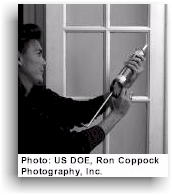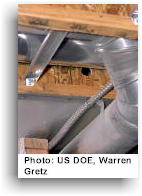
Duct Insulation
Caulking
Heating and cooling ducts often suffer from air leakage through cracks in the ducts where the parts are assembled. An efficient HVAC system is of little use if windows and doors have cracks, allowing outside air to enter while conditioned air escapes. Older ductwork may not be insulated well. A gap of only ¼" around a standard door or window can let in as much air as a softball size hole!
| Duct Insulation Insulating ducts with insulation wrap, and sealing air leaks in ducts, can be among the most effective energy saving strategies. Air leaks are sealed using duct mastic (not tape!) wherever leaks are accessible, in attics, garages, crawlspaces, etc, and should be sealed before adding insulation wrap. A special aerosol duct sealing system is also available in some areas to facilitate sealing leaks in inaccessible ductwork. After the ducts are sealed, they should be protected with low-cost, foil-faced fiberglass insulation. When wrapping the insulation, make sure it is foil-side out. You can seal the insulation seams with regular duct tape. An insulation rating of R-8 is recommended for cold climates. |
|
According to the U.S. Department of Energy Home Energy Saver web site, insulating ducts in the typical American home costs about $250. Duct insulation will pay for itself in energy savings in about two and a half years, and continue to save energy and money in years to come. Even newer systems, that may already be insulated, may be very leaky so don't assume they are tight just because they are insulated. It is best to have a weatherization or HVAC professional who has a duct leakage testing device test your ductwork to be sure.
Caulking
Check for cracks and small holes around your doors and windows, and seal them with caulk around windows and weather stripping around doors. Not only will you save money, you will also increase the comfort level of people inside. Also, while caulking, take the opportunity to fix broken glass, and see that windows and doors close properly.
 | Your local hardware dealer can help select the appropriate type of caulk or weather stripping for the job, or call your maintenance contractor. The most common, durable caulk used for interior and exterior applications for cracks and gaps less than 3/8" is polyurethane. Polyurethane caulk, comparable to silicone but less costly, is easy to apply and can be purchased in either semi-liquid or liquid spray foam that expands. For each window, you will need approximately one-half tube of caulk. For large gaps, apply reusable rope caulk. Weather stripping materials help to prevent air infiltration around windows and doors by eliminating gaps between the frames and moving parts. There are a variety of different kinds of weather stripping for different applications. Again, your local hardware dealer can help in the selection. |
|
|
|
| Copyright © Aclara Technologies LLC. All Rights Reserved. | |
